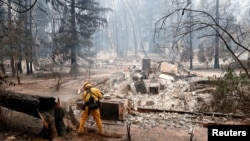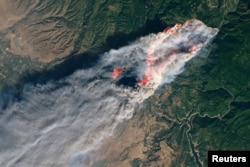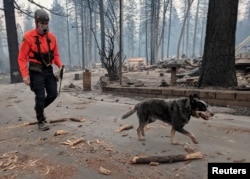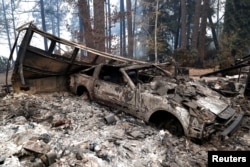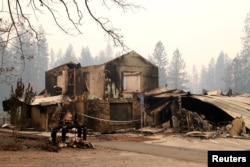Paradise, California had long prepared for wildfires but only in its worst nightmares did it imagine the kind of "megafire" that last week destroyed most of the town and killed at least 42 people.
Born of tinder dry conditions and erratic winds, the "Camp Fire" was the latest California megafire, a huge blaze that burns more intensely and quickly than anything the state has experienced before.
In recent years authorities in California have reported an increase in such large, explosive and swiftly spreading wildfires over a virtually year-round fire season.
Four out of the five largest fires in California history have occurred in the last six years.
No rain for over 200 days
Paradise had not seen significant rain for 211 days, and the town, on a ridge in the foothills of the Sierra Nevada mountains, was surrounded by a potential bonfire of dry or dead trees following a five-year drought that ended in 2017.
Less rain and longer droughts are the major cause of the blazes, which consume more than 100,000 acres (40,000 hectares), according to recent research by the U.S. Forest Service and University of Montana.
After a wildfire destroyed 87 homes in Paradise in 2008, the town of 27,000 put evacuation plans in place and fined homeowners if they did not clear brush and prune trees to reduce fire risk.
But all it took was some kind of spark on Camp Creek Road, west of Paradise, and "El Diablo" fall winds gusting up to 50 mph (80 kph), to unleash the most destructive and deadly wildfire in California history.
‘Not getting on top of it'
As the blaze roared west, devouring nearly 6,500 homes, it created its own fire whirlwinds or "firenados," incinerating an area equivalent to 80 American football fields (100 acres) per minute.
"This event was the worst case scenario. It was the event we have feared for a long time," local sheriff Kory Honea told reporters.
This has been one of the state's worst fire years, with nearly twice the acreage burned so far compared with 2017 in areas managed by the California Department of Forestry and Fire Protection (Cal Fire).
Minimizing the impact
Former U.S. Forest Service officials such as Jerry Williams say too much emphasis is put on fighting fires instead of accepting that they are a natural part of the environment and minimizing their impact. Forests that for millennia had fire as part of their ecosystems have become choked with growth and unhealthy, and ultimately tinder for megafires, he said.
"Every year we set a new record, we invest more in suppression, invest less in mitigation and wonder why we're not getting on top of it," Williams, a former director of fire and aviation for the U.S. Forest Service, said in an interview.
Fire officials say the trend to larger, more destructive fires is driven by drought-stricken vegetation, erratic winds and triple-digit temperatures that are part of climate change.
President Donald Trump has blamed California's failure to thin fuel-choked forests.
Many factors
Cal Fire spokeswoman Lia Parker said there were a lot more factors at play than cutting down trees.
"A lot of it is climate related; we've seen a significant increase in temperatures; we've seen an increase in dry and dead conditions," Parker said.
As the Camp Fire raged, similar conditions nearly 450 miles to the south were fueling the Woolsey Fire, which killed two people and destroyed 370 homes near Los Angeles.
"It was a fire storm, the worst I've ever seen it," said Malibu resident Tony Haynes, 59, who fought the blaze as it threatened his home.




